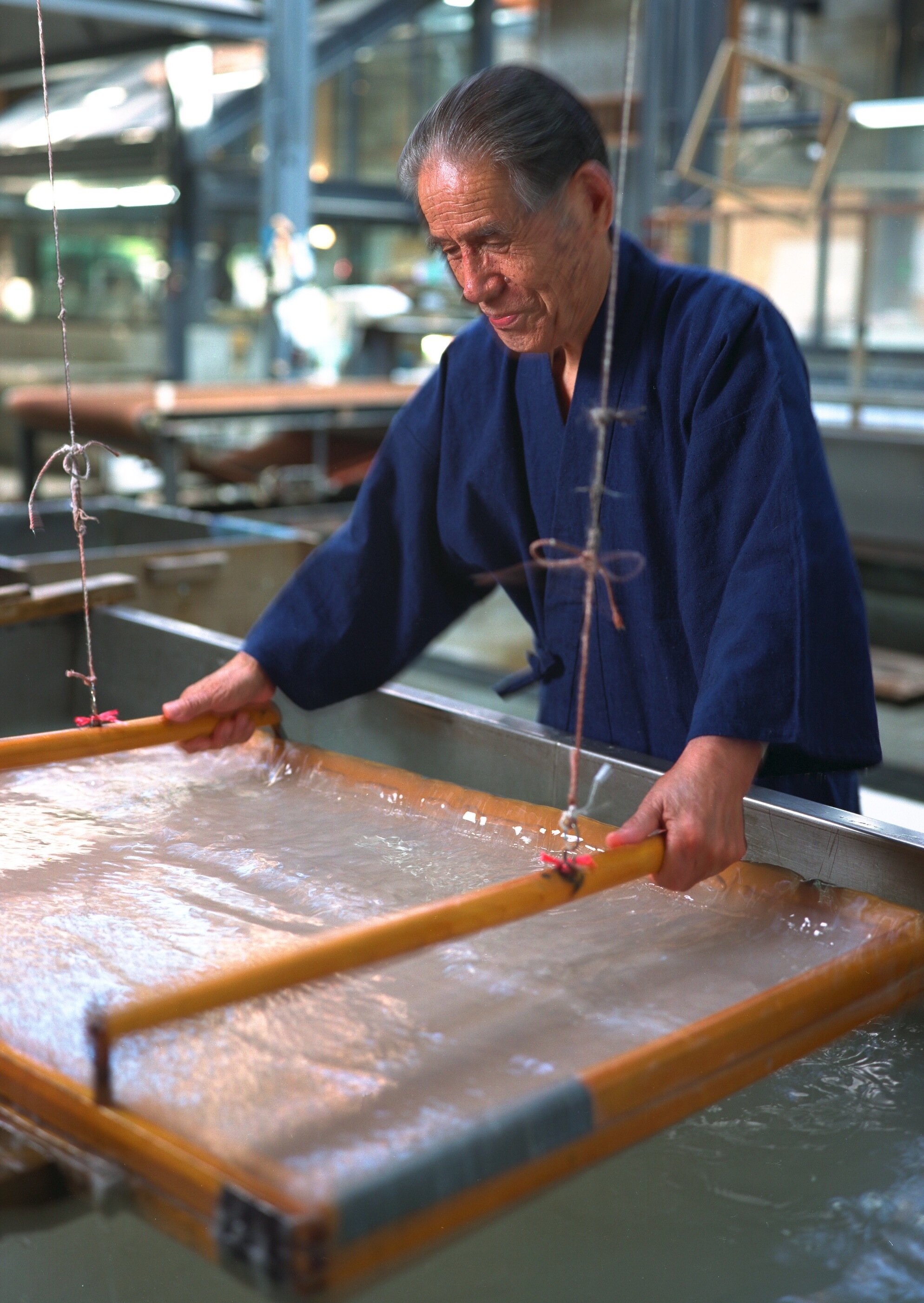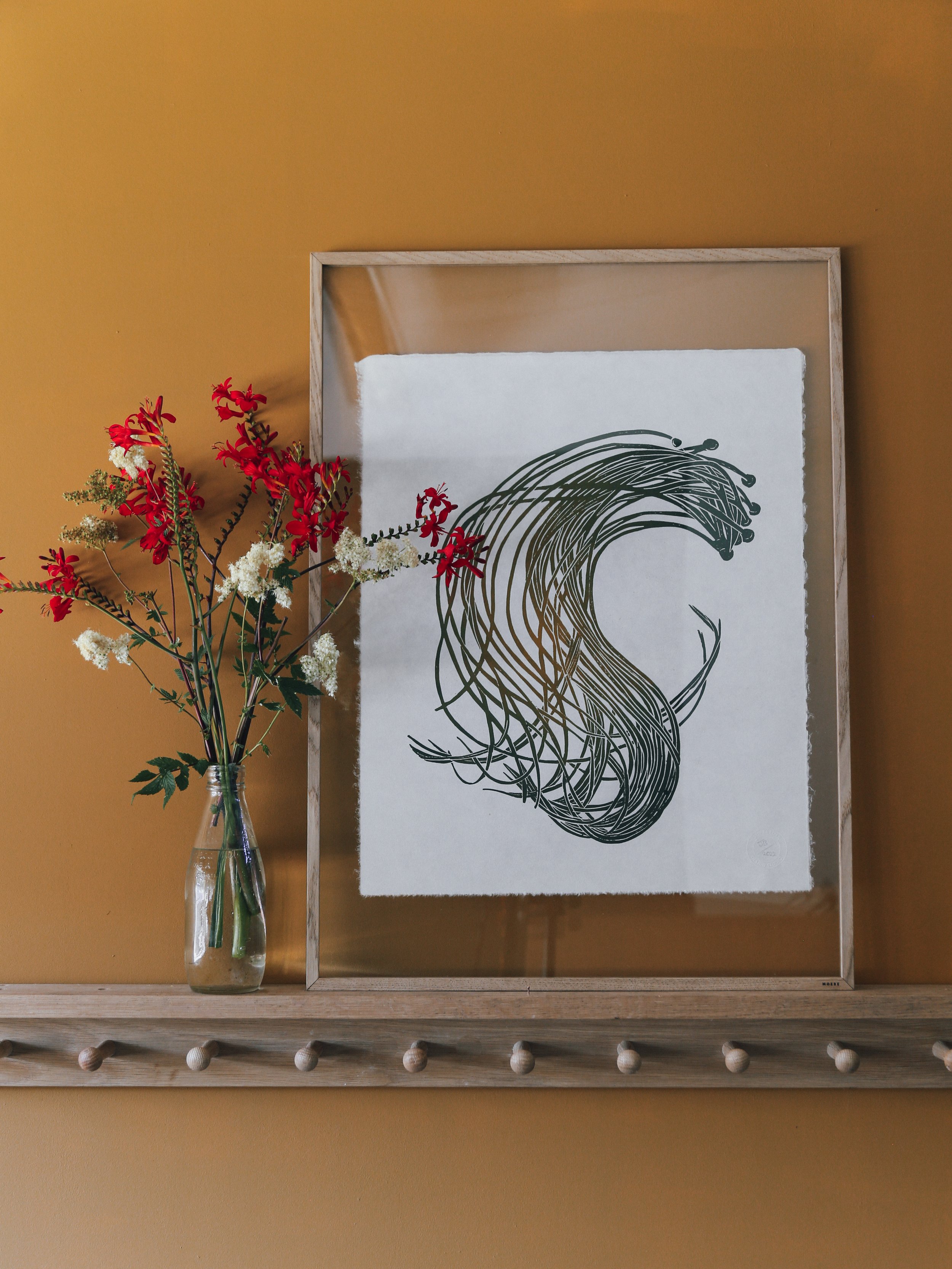GUIDE: All about framing
Superfolk Giant Atlantic Wakame print. Deckle edge exposed. Float mounted in a narrow profile oak frame by Hang Tough.
I see that all the Superfolk prints have something called a deckle edge. What is a deckle edge?
Deckle edge paper has a soft feathery edge instead of a straight, machine-cut edge. A thin, imperfect deckle edge on paper is the result of traditional paper-making techniques. During the paper-making process, a deckle – or wood fence – is placed in the mould to keep the paper slurry within bounds and control the final size of the resulting paper sheet. Inevitably, some of the paper slurry passes under the deckle. It is this overspill that forms that irregular, thin feathered edge.
So then, tell me, should I show or hide the deckle edge when framing my Superfolk print?
That is a matter of personal choice. You might prefer a cleaner look and choose to cover or remove the deckle edge. We recommend celebrating and showing off the soft feathery deckle edge. We see it as a reminder of the handmade origin of the paper and a celebration of the craftsmanship of those who made it.
I have a space in mind for my print and I was thinking of hanging it horizontally. Is that ok? Is my Superfolk print supposed to hang horizontally or vertically?
The prints are signed - but this is not an indicator of the “correct” orientation. All of our prints are actually designed to hang both vertically and horizontally. So feel free to decide for yourself which way you feel will work best in your space.
What colour frame works best with Superfolk prints?
Again, this is a matter of personal preference. There is no right or wrong frame colour choice. It might help to think about what other materials are in the space you want to hang the print. But don’t allow this to overly dictate your choices. Remember that over time you may choose to hang the print in a different space or part of the same room.
If your budget allows we like the look of a natural finish slim wood frames. The green prints (eg. Summer Beech, Wild Garlic etc) look particularly well with an oak or beech frame. Some of the darker prints such as the Copper Beech tend to look well with a darker wood frame such as a walnut finish.
Bespoke 3 panel Giant Atlantic Wakame print, commissioned by Breac House. Deckle edge not showing. Framed with non-reflective glass by Hang Tough
What type of glass should I choose? It seems to make a big difference to the cost but I don’t really understand the difference between them all.
Special grades of framing glass have been developed to minimise annoying reflections and mitigate the damage that can be caused to artworks by exposure to UV light.
Things to consider here are the value of the piece, how much you are willing to spend and if the piece will be hanging exposed to direct sunlight or not.
This is a really good guide explaining the different options of glass when it comes to professional framing.
Detail of Summer Pond by Superfolk
What is the difference between a solid wood frame and a wood effect frame? They look the same to me.
It is also worth keeping in mind that a big advantage of a solid wood frame is that it can be repaired. If it gets a knock it can be treated with a wax finish or simply sand back the damaged area and re wax. In contrast a wood composite frame (eg mdf with an oak veneer) is not as hardwearing. It can look scuffed and damaged over time, particularly around the corners, and there is not really the option to have it repaired.
Superfolk Sea Spaghetti Wild Seaweed Print framed in clear frame by Moebe
Superfolk Summer Beech Print framed with Large Hanging Rail
So, I am thinking of hanging prints in my kitchen would the hanging rail system work well in this situation?
The hanging frame system is most suitable for a space where there is likely to be not too much moisture, wind, or through traffic.
Hanging frames are great if you want a cheaper, faster, and more lightweight option to professional framing. They are also ideal when giving a print as a gift - for example for a friend’s housewarming present. Say, you know your friend is busy and you think it will be nice for them to have something to quickly and easily take the bare look off their new space. They may then decide in time to invest in having the print professionally framed.
We also sell another instant framing solution from the Danish design studio Moebe. This is a very versatile frame. This frame consists of two pieces of acrylic glass, four sides of untreated oak and a rubber band. The rubber band both holds the frame together and also serves for hanging the frame on your wall. You can choose to fill the frame or leave a gap to show the wall behind.
Rubio, Hang Tough
However, the best long-term solution to hanging a print will always be to have it framed by a professional framer. They will use archival materials and methods and ensure the longevity and stability of your piece. To help us answer your questions about professional framing options we asked the always helpful and generous Rubio at Hang Tough in Dublin. At Hang Tough they offer both high street and conservation framing options to suit a range of budgets. He agreed to answer some of your more specialised framing questions.
What's the difference between reflective and anti-reflective glass?
Rubio: Standard glass is the starting choice of glass for most framers. It is an inexpensive option for glazing your artwork. It is transparent but bounces back reflections, especially in front of dark artworks. Anti-reflective glass is a premium product that is more expensive than standard glass. It offers clarity and in some grades, UV protection. Anti-reflective glass is not to be confused with diffused glass, which is cloudy and reduces clarity
When would it be important to use anti-reflective glass?
Rubio: Anti-reflective glass is always a good choice. It enhances the clarity and colours of the artwork whilst also reducing the bounce back of reflections. Unfortunately, it is not completely reflection proof and will reflect light but overall it is a dramatically better presentation. Anti-reflective glass (AR) glass also comes with UV protection in various grades which will prevent fading of inks and the discolouration of the paper but no glass will prevent damage if the frame is hung in direct sunlight.
When would reflective glass be sufficient?
Rubio: Normal glass offers a wonderful presentation at a fraction of the cost of anti-reflective glass (AR) glass. It is perfectly fine to use for works on paper and can always be replaced for AR glass if the reflections bother you. The thing with AR glass is that when you use it once, you'll always choose it.
What is important to tell my framer when it comes to framing artworks on paper?
Rubio: Paper requires specific care as the fibres react to different humidities. Due to the nature of paper, it will never be perfectly flat. Hinges should be used to allow the paper to expand and contract in the frame as it is exposed to different humidity changes. Dry mounting is a way of keeping the paper flat but this is not advised for works of value. On thin papers, dry mounting will show staining over time as the adhesive starts to discolour which becomes visible from the front.
Is there any special treatment for framing washi paper?
Rubio: Washi is an extremely light paper and is especially contrary when exposed to different humidities. It is important to understand that the paper will react and if rolled may always show rippling or distortion. Keeping the glass off the paper will prevent drastic rippling and distortion. Special transparent hinging and paste are required as normal tape hinges will show through the thin paper.
I want to leave the deckled edge showing. How would I explain this type of mounting to my framer?
Rubio: To show the edges of your artwork ask your framer to float mount your artwork. This can be presented as either a raised float mount or a lay-on float mount
I want to frame the print quite simply. I don’t want anything fussy. My framer says I must use a mount. What is this? And what kind of mount would you recommend?
Rubio: Your framer will always suggest mounting your artwork in order to protect your piece. Mounting your artwork ensures that it will not be pressed up against or touch the glass, which can cause condensation damage and ripples. As well as displaying your artwork in a visually appealing manner mounting will also preserve the condition of your artwork. Therefore it is crucial to use archival materials such as acid-free and preferably museum standard mount board. Using substandard mounts will over time damage your artwork causing foxing.
My son creased the print as he put it back into the tube. Can my framer fix this? What should I do before I bring my print to the framer?
Rubio: It depends on the severity of the crease. Your framer will always suggest bringing your artwork to a paper conservator if you are concerned about the condition of the piece. A conservatory will be able to recommend suggestions as to how to restore your artwork before framing. However if this option is not viable for you there are methods that your framer can employ to try and reduce the appearance of the crease, such as applying heat or small amounts of moisture (all of which depend on the paper and material used). While your framer will always aim to preserve the integrity of your artwork and restore it to its original condition this is not always possible and creasing may still be visible.
I got my print framed but now it has wrinkled. What caused this? Can my framer fix this?
Rubio: Paper is very susceptible to environmental conditions and as such will always expand and contract to some degree, even after framing. Your framer should mount your artwork in such a way to allow for some degree of movement in order to not create tension and inadvertently cause damage to the piece. Artwork hung in areas which have direct sunlight or changeable temperature conditions (above a radiator for example) will be more susceptible to rippling, however, if you think the artwork has not been exposed to such conditions and are concerned about the piece your framer will endeavour to fix the appearance of the rippling to the best of their ability. However, it is not a guarantee that paper will ever remain perfectly flat. Your framer might also suggest a different mounting method, such as window mounting to further reduce the appearance of any rippling.
Thanks a million, Rubio!
Notes:
More on our Journal: The Making of Japanese Paper or Washi
Browse Instant Framing Solutions
More about Rubio and Hang Tough








